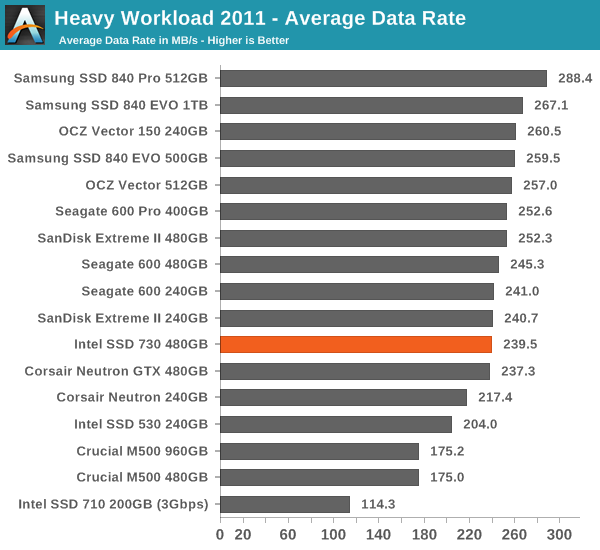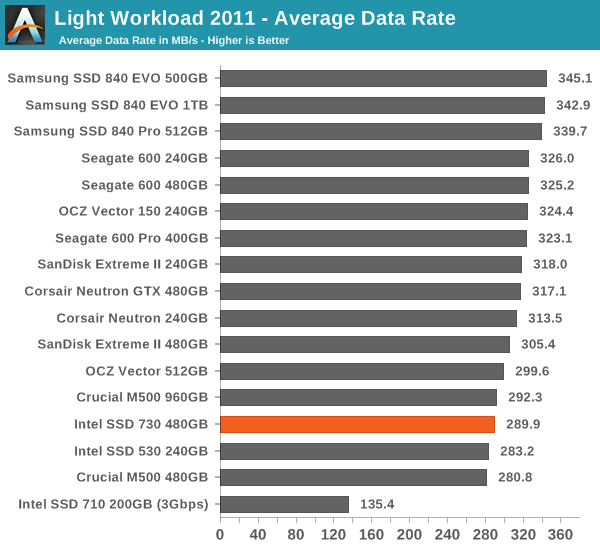Intel SSD 730 (480GB) Review: Bringing Enterprise to the Consumers
by Kristian Vättö on February 27, 2014 12:00 PM EST- Posted in
- Storage
- SSDs
- Intel
- Intel SSD 730
AnandTech Storage Bench 2011
Back in 2011 (which seems like so long ago now!), we introduced our AnandTech Storage Bench, a suite of benchmarks that took traces of real OS/application usage and played them back in a repeatable manner. The MOASB, officially called AnandTech Storage Bench 2011 - Heavy Workload, mainly focuses on peak IO performance and basic garbage collection routines. There is a lot of downloading and application installing that happens during the course of this test. Our thinking was that it's during application installs, file copies, downloading and multitasking with all of this that you can really notice performance differences between drives.
We tried to cover as many bases as possible with the software incorporated into this test. There's a lot of photo editing in Photoshop, HTML editing in Dreamweaver, web browsing, game playing/level loading (Starcraft II & WoW are both a part of the test) as well as general use stuff (application installing, virus scanning). We've included a large amount of email downloading, document creation and editing as well. To top it all off we even use Visual Studio 2008 to build Chromium during the test.
The test has 2,168,893 read operations and 1,783,447 write operations. The IO breakdown is as follows:
| AnandTech Storage Bench 2011 - Heavy Workload IO Breakdown | ||||
| IO Size | % of Total | |||
| 4KB | 28% | |||
| 16KB | 10% | |||
| 32KB | 10% | |||
| 64KB | 4% | |||
Only 42% of all operations are sequential, the rest range from pseudo to fully random (with most falling in the pseudo-random category). Average queue depth is 4.625 IOs, with 59% of operations taking place in an IO queue of 1. The full description of the test can be found here.
AnandTech Storage Bench 2011 - Heavy Workload

AnandTech Storage Bench 2011 - Light Workload
Our light workload actually has more write operations than read operations. The split is as follows: 372,630 reads and 459,709 writes. The relatively close read/write ratio does better mimic a typical light workload (although even lighter workloads would be far more read centric). There's lots of web browsing, photo editing (but with a greater focus on photo consumption), video playback as well as some application installs and gaming.
The I/O breakdown is similar to the heavy workload at small IOs, however you'll notice that there are far fewer large IO transfers.
| AnandTech Storage Bench 2011 - Light Workload IO Breakdown | ||||
| IO Size | % of Total | |||
| 4KB | 27% | |||
| 16KB | 8% | |||
| 32KB | 6% | |||
| 64KB | 5% | |||

Again, the SSD 730 comes up with relatively uninspiring performance in this lighter, older workload. If your usage patterns are relatively tame, a drive designed for enterprise usage scenarios may be more than you need and may actually end up performing slower than "lesser" drives in day-to-day use—not that you'd likely notice, as most decent SSDs are now at the point where to normal users they're all plenty fast.










96 Comments
View All Comments
Neo Zuko - Monday, March 3, 2014 - link
Or more exactly, why is the SanDisk Extreme II better than the Samsung 840 Pro for Anandtech?coder111 - Tuesday, March 4, 2014 - link
Regarding hardware encryption- don't use it. Seriously, these days, can you really trust anything but open-source encryption not to have backdoors for NSA, FBI, GCHQ or any other intelligence, police or RIAA/MPAA agencies out there?I do understand hardware encryption is faster, easier, more transparent. But there is no way to prove it's correct. And if it can be bypassed by government, it's useless.
psyq321 - Monday, March 10, 2014 - link
How can you trust anything that you didn't write from the zero (including compiler >and< hardware)? Who is to attest that your compiler or compiler used to compile your favorite distro/software is not injecting backdoors? Who is to attest that your hardware does not have a firmware-level exploit that can be used to log keys?Can you trust software with millions of lines of code that you did not write?
Nope, you can't. Even open source software has a history of lingering vulnerabilities that stuck for >ages< (Debian pseudo "random" number generator, for example).
If you think your communication is going to be targeted by any government, the best idea is to be as paranoid as it gets and use multiple measures perhaps including >both< hw. level and software encryption.
If you are, like majority of businesses, mostly concerned whether your disk might fall into wrong (criminal) hands, then disk-level hardware encryption would probably be not worse than software encryption.
amddude10 - Friday, November 28, 2014 - link
It could be helpful to avoid the wrong information getting into the hands of a competitor or something like thatHrel - Wednesday, March 5, 2014 - link
Those Seagate drives are looking better every day. I just saw a 240GB one on Newegg for $120!!!!preamp - Tuesday, March 11, 2014 - link
Ouch! "(...) the chassis also gets very hot and uncomfortable to touch under load" should translate something like 50°C on the outside of the SSD, which means that the electrolytics will constantly be cooked.Granted, the Chemi-Con KZH are rather good ones (although not the most reliable out there) with a rating of 5000 hours at 105°C, but I've had rather bad experiences with any electrolytics running hot in unvented cases for extended periods of time.
According to the Illinois Lifetime Calculator those caps should last for more than 20 years at 60°C and 12V, but personally I have my doubts that the power loss "protection" is still working up to spec while approaching end of warranty...
crazzeto - Tuesday, March 11, 2014 - link
Funny, I actually just bought a Crucial M500 (240GB) for my ~6yr old HP DV6500 Media Laptop. I guess I was a little surprised to see generally this isn't even the fastest ssd lol. It's been a number of years since I've been a serious home builder, so I'm not fully in touch.Anyway I'm blown away by what a difference it makes even in this ancient machine running Vista 64B with just 2GB ram.
binarycrusader - Tuesday, June 17, 2014 - link
NewEgg as of today (for the next 24 hours or so?) is running a special on this drive, $379.99 for the 480GB model, which makes it a lot more appealing.KAlmquist - Saturday, November 22, 2014 - link
And today the price is $110 for the 240GB drive and $200 for the 480GB drive. The latter price is actually ten dollars less than the 512GB Crucial MX100. So Intel seems to be serious about selling these drives in quantity.amddude10 - Friday, November 28, 2014 - link
Yes, and similar sale prices in Canada as well. They still show the original MSRP in sales to try to make it seem like a better deal, but the actual MSRP seems to have come down significantly as well.As far as I know, the 730 is the only drive with full power loss protection in the consumer segment, which, along with Intel's awesome drive monitoring functionality, makes this the most attractive SSD in my mind. It makes me wonder... what's the catch? I really don't care about the lower speed (especially on the 240gb model).